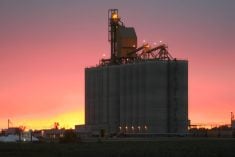Each family farm is unique, having its own structure and assortment of inhabitants, both animal and human. Other vital components are the traditions, fashioned and nurtured by its members. A tradition established on our east-central Saskatchewan farm during the 1970’s was a visit to the beaver dam each spring. The dam had been built years before on the narrow creek, which winds across our home quarter about half a mile south of the farm yard. Beyond, was the summer pasture where the cattle herd grazed with its ever-increasing number of spring calves.
Read Also

Cancer agency reclassifies another herbicide ‘probably carcinogenic’
The WHO’s cancer research agency has now put atrazine, a herbicide well known to corn growers, in the same potential-hazard category where the agency put glyphosate.
On a Sunday afternoon, when the first robin had made its appearance and the frogs had emerged from their frozen mud bed for the third time, an eager troop of Loobys would trek through a gopher-hole pocked hay field and across the creek to view the motley band of new arrivals.
Even before it came into view, we felt the chill of the creek water; breathed in the pungent smell of pitch and rotting bark left by the beavers’ daily toil. We approached in hushed reverence, watching the larvae and tadpoles as they interrupted the stretch of silent water, darting among mossy mounds and tangled weeds. The slender, coffee-brown bulrush’s stood erect waving a welcome to the budding, buttery marsh marigolds.
Willows leaned, dipping their branches in a curtsy to the lordly beaver as he patrolled the banks. His house, although to us an unsightly collection of weathered branches, had been tidied inside in readiness for this season’s young. The rustle of the leaves beneath our feet alerted the guard as we approached. His shiny rump broke the surface of the water; his thick tail curved upward and slammed the water like a whip, sending a spray of droplets over his unsuspecting audience.
We continued over the homemade wooden bridge to the pasture, where furry bundles on scrawny legs stumbled behind their mothers. Some bounded across the grassy field and into the gullies as we approached. The cattle, their spring coats glistening over taut muscles, ceased their grazing only for a moment, ears forward, eyes wide with curiosity.
“How many calves ya’ got now, Dad?” a youngster asked. His father’s reply was slow and calculated. “Well, maybe about 35.”
I knew there was no “maybe” or “ about” in his mind. He not only knew exactly how many there were, but which cows had freshened, when, what her lineage was, her age and her strengths and weaknesses. I knew, too, that he had already decided which animals must be sold in the fall and which he would hold back for breeding. And as we wandered back home, we were heady with hope for the coming season. There was joy enough to last forever.
But there’s no such thing as forever, not even in this humble hideaway of ours.
“To everything there is a season…” A time to reap and a time to sow…A time to milk , a time for haying, a time for baby animals and as the years passed, there came a time not to do those things anymore.
It was late March of 1987.
Our children were growing up and some had already left home. My husband was sitting at the kitchen table sorting through some fuel bills one afternoon, and as he reached for the papers, his fingers refused to function. He got up slowly and with unsure steps moved down the hallway to the bedroom, where he stretched out on the bed. There was a persistent pounding over his left eye, he told me. I made an effort to suppress my inner panic but the full impact of the situation came with his honest words: “I don’t feel well. I think I’m having a stroke.”
His recovery was slow and we all knew there were serious decisions to be made. The cattle would have to go.
We advertised and buyers came and went, bargaining, speculating. Finally a deal was stuck. We built a temporary holding corral with poles cut in a nearby spruce bluff, brought the herd up from the summer pasture and waited.
It was a perfect summer day, clear and warm. A light breeze teased the poplar leaves and a yellow warbler surveyed the yard from atop a Mountain Ash beside the house. Suddenly, the calm was broken by the rumble of a diesel motor and a brilliant metallic-blue cattle truck rumbled through the gate and across the yard. The sun’s rays danced like strobe lights against its surface. As the truck eased back against the chute, I sensed that it had now become a painful symbol, for it would take with it, not just the animals, but our entire lifestyle.
Covered with sweat and foam, the cattle jostled their way up the ramp. The steady drive of their hooves shook the truck, the ramp and the very earth that had provided a home for them since birth. The manifest was signed, the back door of the truck secured and the driver climbed into the cab. As he maneuvered around the barn and out the driveway, utter desolation and heart-rending silence settled over the barnyard.
The only evidence now, that the herd had ever existed, was the torn turf and the greenish-brown smears splattered over the ground by the frightened beasts. The bellowing, bawling, bleating, echoed in my mind as I stared at the empty corral.
At the beaver dam, life continues undisturbed. Red-winged blackbirds shrill their messages, as they cling to the swaying bulrushes. Mallards and Canada Geese discuss the merits of the accommodations available along the creek bank and the tiny pond creatures dart across the water performing their rituals, as Nature’s unswerving circle of life goes on. In the pasture beyond, the grass grows tall, the wire sags and the fence posts are beginning to lean. Only ghostly beasts inhabit the place.
And thus I consider the significance of that fleeting moment we humans call a lifetime.
In 1956, Peggy (Hayes)Looby joined her husband, Joe, on his farm in East Central Saskatchewan. Together, for over 30 years, they operated a mixed farm while simultaneously raising a family of three boys and six girls. During that time, Peggy gathered and filed material for her articles. Today she writes in the solitude of the century-old homestead, established by her father-in-law in 1906.














